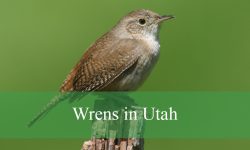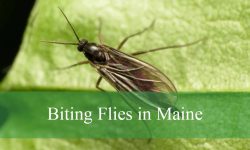Doves are graceful and gentle birds that bring a sense of calm to the landscapes of Maine. With their soft cooing calls and elegant flight, these birds are often associated with peace and harmony. From bustling city streets to quiet farmlands, doves have adapted to a wide variety of habitats across the state.
In Maine, three species of doves can be observed: the Mourning Dove, Rock Pigeon, and Eurasian Collared-Dove. Each species shows unique patterns in size, color, and behavior, making them fascinating to study. While some are long-time residents of the region, others are more recent arrivals expanding their range northward.
Observing doves in Maine provides a glimpse into their adaptability, survival strategies, and interaction with human environments. Learning to recognize their calls, habits, and nesting behaviors adds depth to the experience of birdwatching in the Pine Tree State.
Different Types of Doves Found in Maine
Mourning Dove (Zenaida macroura)
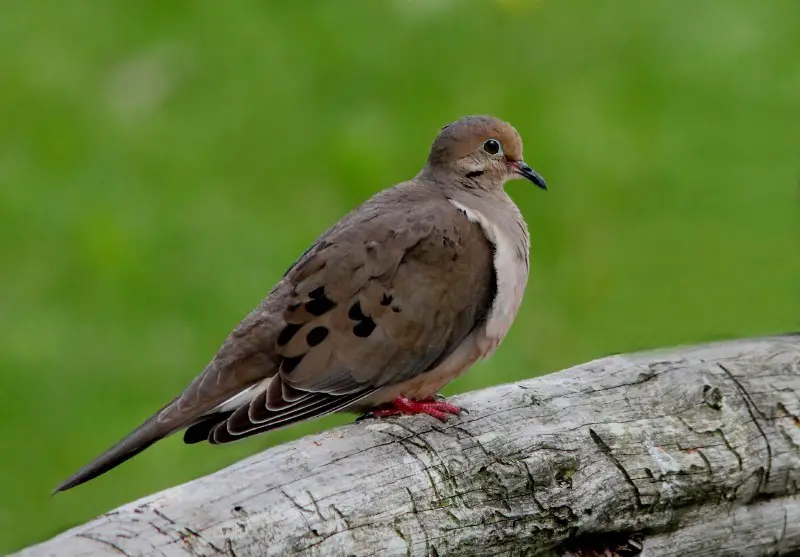
The Mourning Dove is the most widespread dove species in Maine, easily recognized by its slender body, small head, and long pointed tail edged with white. Adults usually measure about 9–13 inches in length with a wingspan of 17–18 inches, and weigh around 4 ounces. Their plumage is soft brownish-gray with black spots on the wings, blending seamlessly into open fields and suburban backyards. Their large, dark eyes and delicate beak give them a gentle appearance that birdwatchers often associate with peace.
One of the most distinctive features of this species is its mournful cooing sound, which gives the bird its name. The call is a soft “coo-oo, coo, coo,” often mistaken for the sound of an owl from a distance. During flight, Mourning Doves produce a sharp whistling sound with their wings, an adaptation thought to serve as an alarm signal to other birds. Their voices are most active during the breeding season in late spring and summer when males court females with persistent cooing.
Mourning Doves are ground foragers, feeding mainly on seeds, grains, and occasionally small insects. In Maine, they are often seen in farmlands, roadside edges, and bird feeders filled with millet or cracked corn. They swallow seeds whole, storing them in their crop and later digesting them. Their ability to consume large amounts quickly allows them to avoid predators by spending less time exposed on the ground.
Breeding usually begins in May in Maine, when males perform aerial displays and courtship feeding to attract mates. Nests are loosely built from twigs and grasses, typically placed in shrubs, trees, or even on human structures like porches. Females generally lay two white eggs, which hatch after about two weeks of incubation. Both parents share nesting duties, and young doves fledge within 12–15 days, making this species capable of raising multiple broods in one season.
In Maine, Mourning Doves thrive in open landscapes, agricultural areas, and suburban neighborhoods. They are resilient to human presence and remain common throughout the state except in densely forested regions. During harsh winters, some migrate south, but many remain year-round, taking advantage of backyard feeders. Their adaptability makes them one of the most familiar and cherished birds for both hunters and bird enthusiasts.
Rock Pigeon (Columba livia)
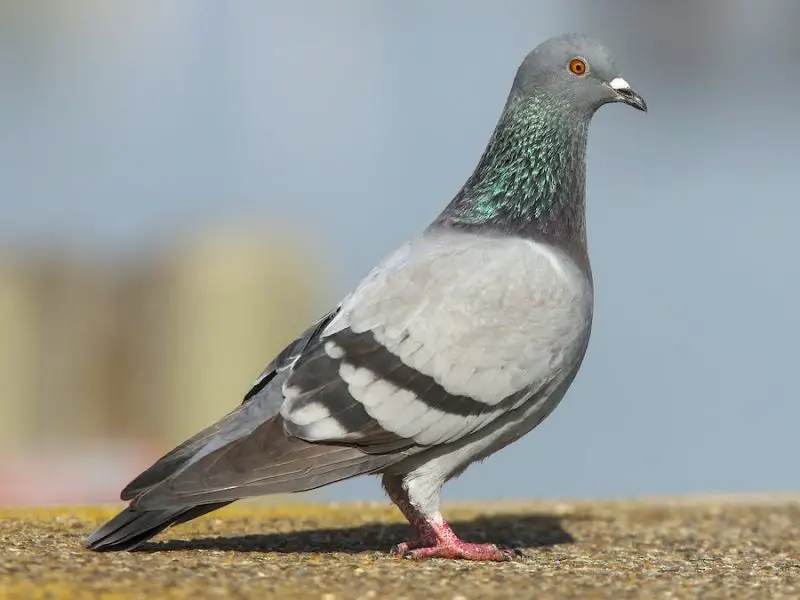
The Rock Pigeon, often simply called a pigeon, is another common dove species found in Maine, especially in cities and towns. Originally introduced from Europe, these birds have adapted perfectly to urban environments, nesting on buildings, bridges, and barns. They are medium-sized birds measuring about 11–13 inches in length with a wingspan of 20–25 inches. Their plumage is highly variable, ranging from blue-gray with iridescent green and purple neck feathers to pure white, mottled, or even dark brown variations.
Rock Pigeons are highly social birds, often seen in flocks numbering from a few dozen to several hundred individuals. They are strong fliers, and their distinctive whirring wings make them noticeable in city skies. Unlike the soft cooing of the Mourning Dove, the pigeon’s call is a low, repetitive “coo-roo-coo,” which is especially audible around nesting areas. Their wing-clapping display during flight is a behavior associated with courtship and territorial defense.
Feeding habits of Rock Pigeons are highly opportunistic. They consume grains, seeds, fruits, and discarded human food. In Maine’s towns and coastal communities, they are often found scavenging near restaurants, waterfronts, and agricultural storage areas. They use their unique ability to suck water through their beaks, unlike most birds that need to tilt their heads back to swallow. This adaptation makes them efficient drinkers in both natural and urban environments.
Rock Pigeons breed year-round in Maine’s milder urban areas, especially in southern regions. Their nests, often built on ledges or building crevices, are made of sticks and debris. Females typically lay two white eggs, and both parents take turns incubating for about 17–19 days. The chicks, called squabs, are fed a nutrient-rich secretion known as “pigeon milk,” produced in the crop of both male and female parents. Squabs usually fledge after 4–6 weeks.
In Maine, Rock Pigeons are most abundant in Portland, Bangor, and other towns where human activity provides reliable food and shelter. They are less common in remote forests or rural countryside unless farms or grain silos are nearby. While sometimes considered a nuisance due to droppings and flocking behavior, Rock Pigeons play an important role in urban ecosystems and remain a familiar sight to both city dwellers and birdwatchers.
Eurasian Collared-Dove (Streptopelia decaocto)
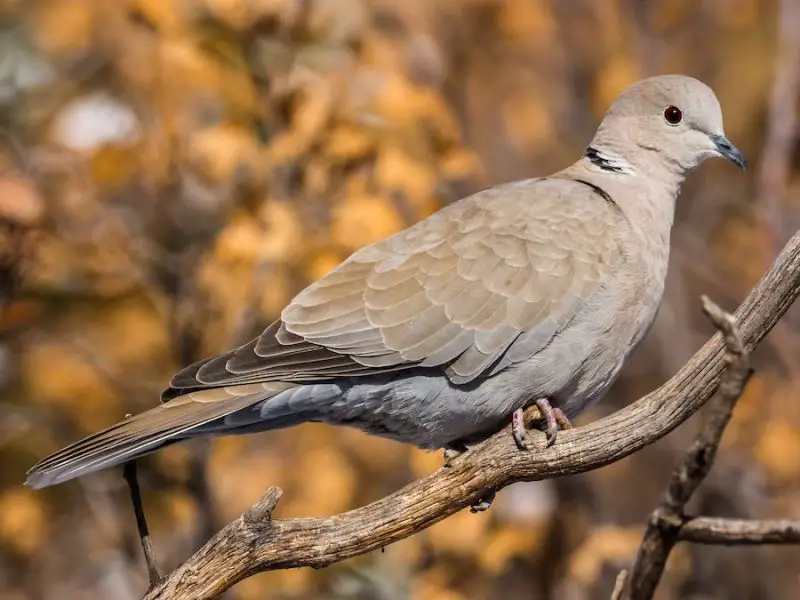
The Eurasian Collared-Dove is a relatively new arrival to Maine, first appearing in the state in the early 2000s. This species is slightly larger than the Mourning Dove, measuring about 11–12 inches in length with a wingspan of 18–22 inches. They have pale gray plumage, a slender black bill, and a distinctive narrow black collar edged with white on the back of the neck, which makes identification straightforward. Their square-tipped tail with white outer feathers further distinguishes them from other doves.
Their call is a three-part “coo-COO-coo,” which is louder and more repetitive than the Mourning Dove’s softer cooing. This call is often repeated dozens of times and is a key way to detect their presence, especially in suburban areas. When flushed, they take off with a strong, direct flight, showing their white tail edges clearly. Their voice and appearance have made them easily recognizable as they expand across the United States.
Eurasian Collared-Doves feed primarily on seeds, grains, and occasionally berries. In Maine, they are usually found around backyard feeders, farmlands, and suburban parks where food is plentiful. They are ground feeders like other doves but are less shy, often perching on utility lines, rooftops, and fence posts. Their adaptability to human environments has allowed them to spread rapidly across North America since first arriving in Florida in the 1980s.
Breeding in Maine usually takes place in late spring through summer. Their nests are simple platforms of sticks built in trees, shrubs, or human structures. Females generally lay two white eggs, incubated by both parents for about 14–16 days. Young doves fledge in just over two weeks, and pairs may raise multiple broods during the warmer months. Unlike Mourning Doves, these doves can sometimes continue nesting well into autumn.
In Maine, Eurasian Collared-Doves are still considered uncommon but are increasing in number, particularly in southern counties and coastal towns. They prefer suburban neighborhoods, small farms, and village edges rather than deep forests. Birdwatchers should listen for their distinct three-part cooing near residential areas. As their range continues to expand, sightings are becoming more frequent, and they may eventually become a familiar year-round resident alongside Mourning Doves and Rock Pigeons.
Comparison Table of Doves in Maine
Feature |
Mourning Dove (Zenaida macroura) |
Rock Pigeon (Columba livia) |
Eurasian Collared-Dove (Streptopelia decaocto) |
|---|---|---|---|
Size & Length |
9–13 in long; wingspan 17–18 in; ~4 oz |
11–13 in long; wingspan 20–25 in; heavier build |
11–12 in long; wingspan 18–22 in; medium weight |
Plumage |
Soft brown-gray with black spots, long pointed tail edged in white |
Variable: blue-gray with iridescent neck feathers, also white or mottled forms |
Pale gray with a distinctive black neck collar bordered in white |
Call |
Soft, mournful “coo-oo, coo, coo”; wings whistle in flight |
Low repetitive “coo-roo-coo”; wing claps in displays |
Loud three-part “coo-COO-coo” repeated frequently |
Behavior |
Ground forager; quick seed eater; partly migratory |
Highly social, flocking; adapted to urban life |
Expanding species, often perched on wires, rooftops, and feeders |
Breeding |
Nest of twigs; 2 white eggs; incubation 14 days; multiple broods |
Nest in ledges/buildings; 2 white eggs; incubation ~17–19 days |
Stick nest in trees or structures; 2 white eggs; incubation 14–16 days |
Habitat in Maine |
Farmlands, open fields, suburban yards, feeders |
Cities, towns, barns, bridges, silos; less in forests |
Suburbs, coastal towns, small farms; uncommon but spreading |
Presence in Maine |
Widespread and common across the state |
Abundant in urban and agricultural settings |
Rare but increasing, especially in southern Maine |
Fun Fact |
One of the most hunted game birds in North America |
Introduced from Europe; ancestor of domestic pigeons |
Spread rapidly across North America since 1980s |
Best Time and Place to See Doves in Maine
The best time to observe doves in Maine is during the warmer months, especially from May through September, when breeding activity peaks, and their calls are most frequent. During this period, Mourning Doves are active in farmlands and open country, Rock Pigeons gather in towns and cities, and Eurasian Collared-Doves become more noticeable in southern suburban areas.
Mourning Doves are commonly spotted in fields, roadside edges, and backyard feeders, particularly where millet or cracked corn is offered. Rock Pigeons are easiest to see in downtown areas, near bridges, old buildings, and barns, often flocking in large groups. Eurasian Collared-Doves are best found in southern Maine towns, coastal neighborhoods, and small farms, where their repetitive three-part coo can often be heard.
For birdwatchers, early morning and late afternoon are the best times to watch doves, as they are most active in foraging and calling. In winter, Mourning Doves and Rock Pigeons remain common around feeders and farmsteads, while Collared-Dove sightings are more limited but steadily growing.
FAQs about Doves in Maine
What is the most common dove in Maine?
The Mourning Dove is the most common dove in Maine. It is widespread across farmlands, suburban yards, and open fields, easily recognized by its soft brown-gray plumage and mournful cooing.
Are Rock Pigeons native to Maine?
No, Rock Pigeons are not native to Maine. They were introduced from Europe centuries ago but have since become established in cities and towns, where they thrive around human structures.
Can I see Eurasian Collared-Doves in Maine?
Yes, but they are still considered uncommon. They are mostly found in southern Maine, especially in coastal towns and suburban areas. Their population is increasing, and sightings are becoming more frequent.
Do doves stay in Maine year-round?
Rock Pigeons and Eurasian Collared-Doves generally remain in Maine throughout the year. Mourning Doves are partly migratory—many stay year-round if food is available, but some migrate south during harsh winters.
What do doves eat in Maine?
All three species feed primarily on seeds and grains. Mourning Doves prefer seeds from weeds and grasses, Rock Pigeons eat a mix of grains and human food scraps, while Eurasian Collared-Doves feed on seeds, berries, and grains often found at backyard feeders.


